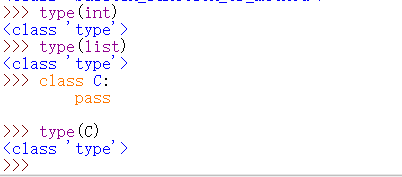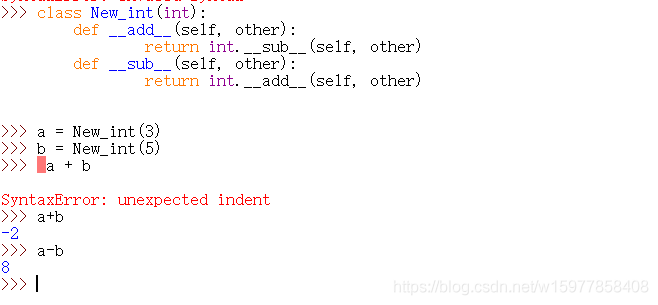魔法方法:算术运算+习题复习
##算术运算
(在Python2.2之前,类和类型是分开的,是不同的东西,类就是一个属性和方法的一个封装,而类型就是像我们的整型啊、浮点型啊,字符串啊之类的,但是在Python2.2之后,作者试图对这两个东西进行统一,做法就是将 int()、float()、str()、list()、tuple() 这些 BIF 转换为工厂函数,那什么是工厂函数呢?)

(当换成int、list、以及自己定义的类)

(返回的是class“type”,当一个类定义完了之后他叫做类对象,也就说,所谓的工厂函数事实上就上类对象)
(Python的魔法方法还提供了让你自定义对象的数值处理,通过对我们这些魔法方法进行重写,你可以自定义任何对象间的算术运算。)
| __add__(self, other) |
定义加法的行为:+ |
| __sub__(self, other) |
定义减法的行为:- |
| __mul__(self, other) |
定义乘法的行为:* |
| __truediv__(self, other) |
定义真除法的行为:/ |
| __floordiv__(self, other) |
定义整数除法的行为:// |
| __mod__(self, other) |
定义取模算法的行为:% |
| __divmod__(self, other) |
定义当被 divmod() 调用时的行为,divmod(a, b)返回一个元组:(a//b, a%b) |
| __pow__(self, other[, modulo]) |
定义当被 power() 调用或 ** 运算时的行为 |
| __lshift__(self, other) |
定义按位左移位的行为:<< |
| __rshift__(self, other) |
定义按位右移位的行为:>> |
| __and__(self, other) |
定义按位与操作的行为:& |
| __xor__(self, other) |
定义按位异或操作的行为:^ |
| __or__(self, other) |
定义按位或操作的行为:| |

(这里做了个恶作剧,当a+b被调用时,看到是加法,就会去自动调用add的魔法方法,但我们 返回的不是两者相加,而是两者相减)

(这样会发生无限递归,直到达到python设点的递归深度,当执行a+b,首先是发现加法,执行魔法方法add,b就是other,但是return的时候又是return a+b,self就是和啊绑定的,所以又是发现加法,然后就会一直递归)
##温故知新之习题
0. 自 Python2.2 以后,对类和类型进行了统一,做法就是将 int()、float()、str()、list()、tuple() 这些 BIF 转换为工厂函数。请问所谓的工厂函数,其实是什么原理?
答:工厂函数,其实就是一个类对象。当你调用他们的时候,事实上就是创建一个相应的实例对象。
# a 和 b 是工厂函数(类对象) int 的实例对象
>>> a = int('123')
>>> b = int('345')
>>> a + b
468
1. 当实例对象进行加法操作时,会自动调用什么魔法方法?
答:对象 a 和 b 相加时(a + b),Python 会自动根据对象 a 的 __add__ 魔法方法进行加法操作。
2. 下边代码有问题吗?(运行起来似乎没出错的说^_^)
class Foo:
def foo(self):
self.foo = "I love FishC.com!"
return self.foo
>>> foo = Foo()
>>> foo.foo()
'I love FishC.com!'
答:这绝对是一个温柔的陷阱,这种BUG比较难以排查,所以一定要注意:类的属性名和方法名绝对不能相同!如果代码这么写,就会有一个难以排查的BUG出现了:
class Foo:
def __init__(self):
self.foo = "I love FishC.com!"
def foo(self):
return self.foo
>>> foo = Foo()
>>> foo.foo()
Traceback (most recent call last):
File "", line 1, in
foo.foo()
TypeError: 'str' object is not callable
3. 写出下列算术运算符对应的魔法方法:
答:
运算符
对应的魔法方法
+
__add__(self, other)
-
__sub__(self, other)
*
__mul__(self, other)
/
__truediv__(self, other)
//
__floordiv__(self, other)
%
__mod__(self, other)
divmod(a, b)
__divmod__(a, b)
**
__pow__(self, other[, modulo])
<<
__lshift__(self, other)
>>
__rshift__(self, other)
&
__and__(self, other)
^
__xor__(self, other)
|
__or__(self, other)
4. 以下代码说明 Python 支持什么风格?
def calc(a, b, c):
return (a + b) * c
>>> a = calc(1, 2, 3)
>>> b = calc([1, 2, 3], [4, 5, 6], 2)
>>> c = calc('love', 'FishC', 3)
>>> print(a)
9
>>> print(b)
[1, 2, 3, 4, 5, 6, 1, 2, 3, 4, 5, 6]
>>> print(c)
loveFishCloveFishCloveFishC
答:说明 Python 支持鸭子类型(duck typing)风格。
详见:Python扩展阅读:鸭子类型(duck typing)
##动动手
0. 我们都知道在 Python 中,两个字符串相加会自动拼接字符串,但遗憾的是两个字符串相减却抛出异常。因此,现在我们要求定义一个 Nstr 类,支持字符串的相减操作:A – B,从 A 中去除所有 B 的子字符串。
示例:
>>> a = Nstr('I love FishC.com!iiiiiiii')
>>> b = Nstr('i')
>>> a - b
'I love FshC.com!'
答:只需要重载 __sub__ 魔法方法即可。
class Nstr(str):
def __sub__(self, other):
return self.replace(other, '')
1. 移位操作符是应用于二进制操作数的,现在需要你定义一个新的类 Nstr,也支持移位操作符的运算:
>>> a = Nstr('I love FishC.com!')
>>> a << 3
'ove FishC.com!I l'
>>> a >> 3
'om!I love FishC.c'
答:只需要重载 __lshift__ 和 rshift 魔法方法即可。
class Nstr(str):
def __lshift__(self, other):
return self[other:] + self[:other]
def __rshift__(self, other):
return self[-other:] + self[:-other]
2. 定义一个类 Nstr,当该类的实例对象间发生的加、减、乘、除运算时,将该对象的所有字符串的 ASCII 码之和进行计算:
>>> a = Nstr('FishC')
>>> b = Nstr('love')
>>> a + b
899
>>> a - b
23
>>> a * b
201918
>>> a / b
1.052511415525114
>>> a // b
1
答:
class Nstr:
def __init__(self, arg=''):
if isinstance(arg, str):
self.total = 0
for each in arg:
self.total += ord(each)
else:
print("参数错误!")
def __add__(self, other):
return self.total + other.total
def __sub__(self, other):
return self.total - other.total
def __mul__(self, other):
return self.total * other.total
def __truediv__(self, other):
return self.total / other.total
def __floordiv__(self, other):
return self.total // other.total
当然,你还可以这样做:
class Nstr(int):
def __new__(cls, arg=0):
if isinstance(arg, str):
total = 0
for each in arg:
total += ord(each)
arg = total
return int.__new__(cls, arg)